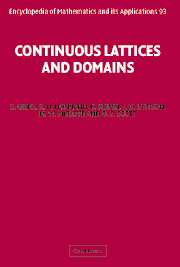Book contents
- Frontmatter
- Contents
- Preface
- Acknowledgments
- Foreword to A Compendium of Continuous Lattices
- Introduction to A Compendium of Continuous Lattices
- O A Primer on Ordered Sets and Lattices
- I Order Theory of Domains
- II The Scott Topology
- III The Lawson Topology
- IV Morphisms and Functors
- V Spectral Theory of Continuous Lattices
- VI Compact Posets and Semilattices
- VII Topological Algebra and Lattice Theory: Applications
- Bibliography
- List of Symbols
- List of Categories
- Index
Introduction to A Compendium of Continuous Lattices
Published online by Cambridge University Press: 13 August 2009
- Frontmatter
- Contents
- Preface
- Acknowledgments
- Foreword to A Compendium of Continuous Lattices
- Introduction to A Compendium of Continuous Lattices
- O A Primer on Ordered Sets and Lattices
- I Order Theory of Domains
- II The Scott Topology
- III The Lawson Topology
- IV Morphisms and Functors
- V Spectral Theory of Continuous Lattices
- VI Compact Posets and Semilattices
- VII Topological Algebra and Lattice Theory: Applications
- Bibliography
- List of Symbols
- List of Categories
- Index
Summary
Background and Plan of the Work
The purpose of this monograph is to present a fairly complete account of the development of the theory of continuous lattices as it currently exists. An attempt has been made to keep the body of the text expository and reasonably self-contained; somewhat more leeway has been allowed in the exercises. Much of what appears here constitutes basic, foundational or elementary material needed for the theory, but a considerable amount of more advanced exposition is also included.
Background and Motivation
The theory of continuous lattices is of relatively recent origin and has arisen more or less independently in a variety of mathematical contexts. We attempt a brief survey in the following paragraphs in the hope of pointing out some of the motivation behind the current interest in the study of these structures. We first indicate a definition for these lattices and then sketch some ways in which they arise.
A DEfiNITION. In the body of the Compendium the reader will find many equivalent characterizations of continuous lattices, but it would perhaps be best to begin with one rather straightforward definition – though it is not the primary one employed in the main text. Familiarity with algebraic lattices will be assumed for the moment, but even if the exact details are vague, the reader is surely familiar with many examples: the lattice of ideals of a ring, the lattice of subgroups of a group.
- Type
- Chapter
- Information
- Continuous Lattices and Domains , pp. xxvii - xxxviPublisher: Cambridge University PressPrint publication year: 2003



